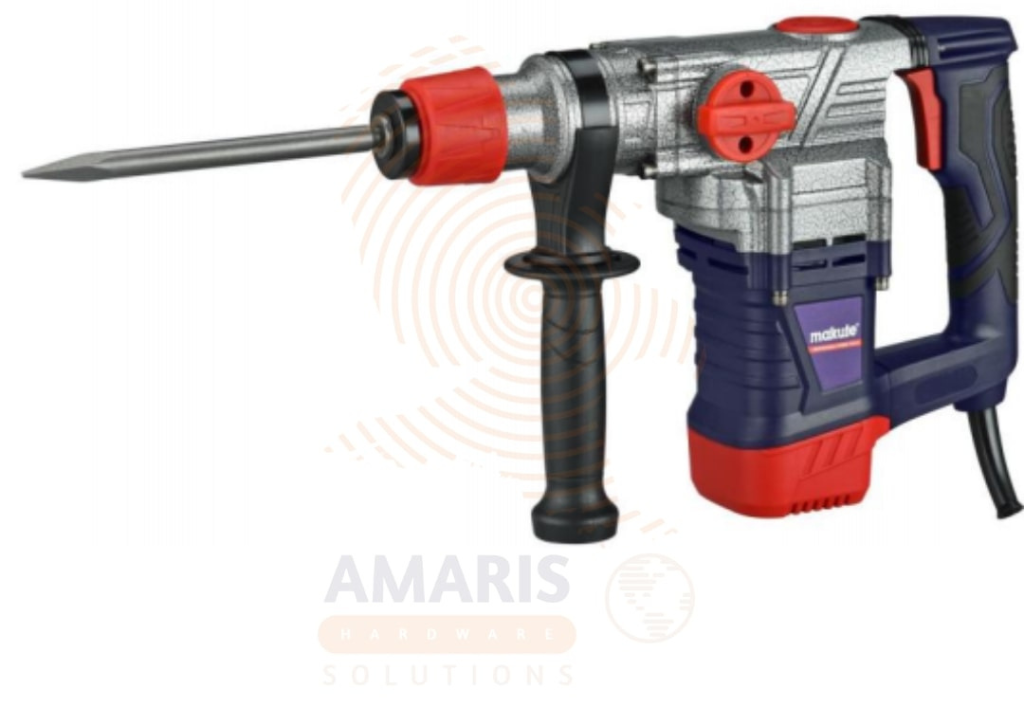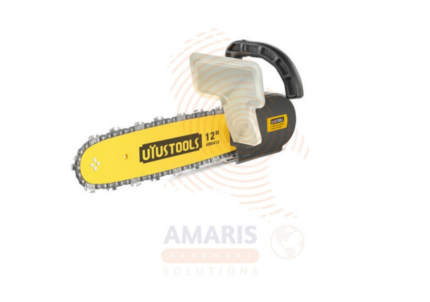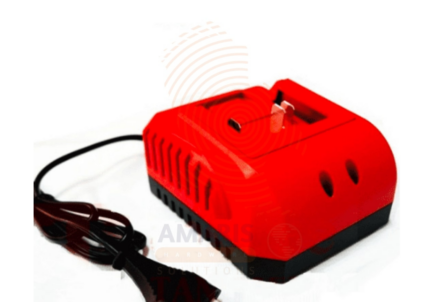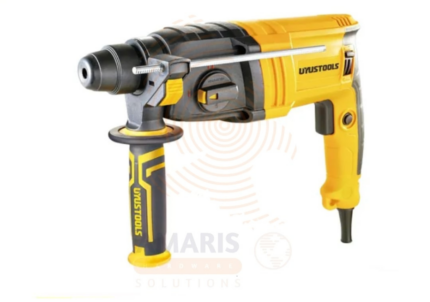
Rotary Hammer
$80.58 Original price was: $80.58.$76.55Current price is: $76.55.
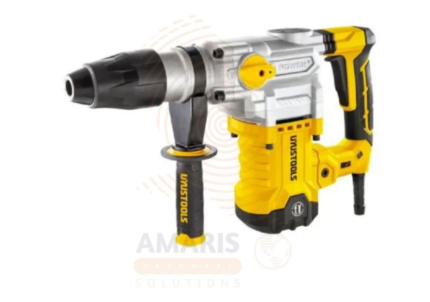
Rotary Hammer Variable Speed
$95.77 Original price was: $95.77.$90.98Current price is: $90.98.
Rotary Hammer Drill
$66.92 Original price was: $66.92.$63.57Current price is: $63.57.
WhatsApp Order
A rotary hammer drill is a powerful and specialized tool designed for drilling into tough materials such as concrete, masonry, or stone. It combines the functions of a regular drill with a hammering action, where the drill bit not only rotates but also moves forward and backward in a hammer-like motion. This dual-action mechanism enables the rotary hammer drill to break through hard surfaces more efficiently than a standard drill, making it an essential tool for tasks like drilling holes in concrete for anchors, bolts, or other construction purposes.
Categories: Drills & Drivers, POWER TOOLS, Rotary Tools
Tags: concrete drill, construction tool, hammer drill, heavy-duty drill, masonry tool, power tool, rotary hammer drill
Description
Table of Contents
ToggleRotary Hammer Drill
Uses
-
Drilling into Concrete and Masonry:
-
One of the primary purposes of a rotary hammer drill is to drill holes in tough materials like concrete, masonry, and stone. This is particularly useful for installing anchors, bolts, or other fasteners in construction projects.
-
-
Demolition Work:
-
The hammering action of the rotary hammer drill makes it effective for light to medium-duty demolition tasks. It can be used to break up and remove concrete, tiles, or other hard surfaces.
-
-
Chiseling:
-
Some rotary hammer drills come with chiseling features, allowing them to be used for tasks like chipping away excess material, shaping surfaces, or removing tiles.
-
-
Installing Electrical Boxes and Pipes:
-
When working on electrical installations or plumbing projects, a rotary hammer drill can be used to create holes in walls or floors for running wires, cables, or pipes.
-
-
Concrete and Masonry Repair:
-
For repair and maintenance work, a rotary hammer drill is essential for drilling holes to inject epoxy or install concrete anchors. It can also be used to remove damaged sections for patching or replacement.
-
-
Landscaping:
-
In landscaping projects, a rotary hammer drill can be employed to create holes for fence posts, outdoor structures, or other installations in hard surfaces like concrete or compacted soil.
-
-
Tile Removal:
-
The hammering action of the rotary hammer drill makes it effective for breaking up and removing tiles from walls or floors during renovation projects.
-
-
Installing Drywall Anchors:
-
When attaching items to walls made of concrete or masonry, a rotary hammer drill is useful for creating the necessary holes for anchors.
-
-
Foundation Work:
-
In construction, rotary hammer drills are often used for drilling into concrete foundations for various purposes, such as installing reinforcing bars or anchors.
-
-
General Construction and Carpentry:
-
Rotary hammer drills find application in various general construction and carpentry tasks where drilling into hard materials is required.
-
SAFETY HANDLING PRECAUTIONS
Safety Precautions
-
Read the User Manual:
-
Familiarize yourself with the user manual provided by the manufacturer. It contains essential information about the tool's operation, safety instructions, and maintenance guidelines.
-
-
Wear Personal Protective Equipment (PPE):
-
Always wear appropriate personal protective equipment, including safety glasses or goggles, hearing protection, dust mask, and work gloves. This gear helps protect against potential hazards such as flying debris, dust, and noise.
-
-
Inspect the Tool:
-
Before use, inspect the rotary hammer drill for any damage or defects. Check the power cord, plug, and other components to ensure they are in good condition. Do not use a damaged tool.
-
-
Select the Right Tool and Accessories:
-
Use the appropriate rotary hammer drill and accessories for the task at hand. Ensure that the drill bit or attachment is securely fitted and in good condition.
-
-
Secure Workpiece:
-
Secure the workpiece firmly in place using clamps or other suitable methods. This prevents movement during drilling and reduces the risk of accidents.
-
-
Use the Proper Drill Bits:
-
Use drill bits designed for rotary hammer drills and suitable for the material you are working on. Using the wrong type of bit can result in damage to the tool or injury.
-
-
Maintain a Firm Stance:
-
Maintain a stable and balanced stance while operating the rotary hammer drill. Keep your feet shoulder-width apart to ensure better control and stability.
-
-
Control the Tool Properly:
-
Grip the tool with both hands, placing one hand on the handle and the other on the auxiliary handle if provided. Keep a firm grip and control the tool to prevent it from slipping or jerking unexpectedly.
-
-
Start Gradually:
-
When starting the rotary hammer drill, begin with a slow speed and gradually increase it as needed. Sudden and excessive force can lead to loss of control.
-
-
Keep Hands Clear:
-
Keep hands and body parts away from the drill bit while the tool is in operation. Avoid reaching over the drill bit or placing hands near moving parts.
-
-
Use Dust Collection Systems:
-
If drilling generates dust, use a dust collection system or wear a dust mask to protect against inhalation of airborne particles.
-
-
Disconnect Power when Changing Bits:
-
Before changing drill bits or accessories, disconnect the power source. This prevents accidental starts and ensures safety during maintenance.
-
-
Turn Off Power when Not in Use:
-
Always turn off the rotary hammer drill and disconnect it from the power source when not in use. This prevents accidental starts and unauthorized use.
-
-
Work in Well-Lit Areas:
-
Ensure that the work area is well-lit, allowing for better visibility and reducing the risk of accidents.
-
-
Follow Electrical Safety Precautions:
-
If using a corded rotary hammer drill, inspect the power cord for damage, and use a grounded electrical outlet. Avoid using damaged extension cords, and keep cords away from the drill bit.
-
Related products
Bi-Metal Hole Saw Set
A 9 PCS Bi-Metal Hole Saw Set refers to a collection of nine hole saws, each constructed with a bi-metal design. A hole saw is a cylindrical cutting tool used to create holes in various materials such as wood, metal, plastic, and more. The term "bi-metal" indicates that the hole saws are made from two different types of metals, typically high-speed steel (HSS) and a more durable alloy like cobalt. This combination enhances the hole saw's cutting performance, making it suitable for a wide range of applications and providing increased durability and longevity. The set typically includes hole saws of different sizes to accommodate various hole diameters, making it a versatile tool for professionals and DIY enthusiasts alike.
Cement Blender – SDS Plus
A cement blender with an SDS-PLUS mechanism typically refers to a power tool designed for mixing cement, mortar, or other construction materials. The term "SDS-PLUS" refers to a specific chuck and bit system commonly used in rotary hammers and drills. SDS-PLUS chucks allow for quick and secure attachment of drill bits and other accessories.
In the context of a cement blender with SDS-PLUS, it likely means that the tool has a specialized chuck system for easy attachment of mixing paddles or blades used in blending cement or similar materials. The SDS-PLUS system is known for its quick-change capability, enhancing efficiency and convenience when working with different attachments. The blender's design may include features to ensure effective mixing of construction materials, making it suitable for tasks like preparing mortar or concrete on construction sites.
Chain Saw Adapter for Angle Grinder
Chain Saw Adapter for Angle Grinder typically refer to components that allow you to attach or use certain accessories with your chainsaw or grinder.
- Chainsaw Adapter:
- A device that enables the use of a 12-inch chainsaw blade on a chainsaw designed for a different blade size. This adapter allows you to customize or replace the original chainsaw blade with a 12-inch one, potentially for different cutting applications.
- Grinder Adapter:
- An accessory that allows you to attach a grinder to a 12-inch chainsaw, converting it into a chainsaw chain sharpener. This adapter facilitates the grinding or sharpening of the chainsaw chain, ensuring optimal cutting performance.
Countersink Drill Set
A countersink drill set typically refers to a collection of six tools designed for countersinking operations in woodworking or metalworking. Each set usually includes six individual countersink drills with varying sizes or angles. Countersinking is a process that involves creating a conical hole in a material, allowing the head of a screw or bolt to sit flush with or below the surface. These drill sets are essential for achieving a professional finish in various applications where a smooth and even surface is desired, such as in carpentry, metal fabrication, or DIY projects.
Fast Charger
A fast charger is a device designed to quickly recharge compatible batteries with a voltage rating of 20 volts. The "fast" designation implies that the charger is engineered to deliver a higher charging current, allowing for a more rapid replenishment of the battery's energy capacity compared to standard chargers. This type of charger is commonly used for power tools, electronic devices, or other equipment that operates on 20V batteries, providing users with a more efficient and time-saving charging solution.
Fibre Strengthened Resin Cutting Wheel
PRODUCT DESCRIPTION
A fiber-strengthened resin cutting wheel refers to a cutting tool designed for various machining applications, particularly in the context of metalworking or construction. This type of cutting wheel is composed of a resin matrix, which serves as a binding material, reinforced with fibers for added strength and durability. The fibers are typically made of materials such as fiberglass or other composite materials.
The combination of resin and fibers enhances the cutting wheel's structural integrity, making it more resistant to breakage and providing improved performance during cutting operations. The reinforced design allows the wheel to withstand higher levels of mechanical stress and heat generated during cutting processes. Fiber-strengthened resin cutting wheels are commonly used in applications like cutting metal, steel, or other hard materials, where precision and durability are crucial.
Flat Knotted Wire Wheel
PRODUCT DESCRIPTION
A knotted wire wheel refers to a rotating tool used in various applications, typically in metalworking and surface preparation. It consists of a wheel-shaped assembly with wire bristles that are tightly twisted or "knotted" together. The wire bristles can be made of steel or other durable materials, and they are arranged in a radial pattern around the wheel.
Knotted wire wheels are commonly attached to power tools such as angle grinders or bench grinders. They are employed for tasks like removing rust, paint, scale, or other surface contaminants from metal surfaces, as well as for deburring or blending welds. The tightly twisted configuration of the wire bristles enhances the wheel's durability and effectiveness in tackling tough materials and applications.
These wheels are available in various sizes and designs to suit different tasks, and they are known for their abrasive action, making them valuable tools in metal fabrication, construction, and maintenance work.
Forstner Bit Set
PRODUCT DESCRIPTION
A Forstner bit set typically refers to a collection of five Forstner drill bits designed for woodworking applications. Forstner bits are specialized cutting tools used to bore flat-bottomed holes with clean and precise edges in wood. The set usually includes five bits with varying diameters, allowing users to choose the appropriate size for different projects. These bits often feature a center point for accurate positioning, two sharp outer cutting edges, and a cylindrical shape. The set is versatile and suitable for tasks like drilling holes for dowels, creating pocket holes, or countersinking screws in woodworking projects.


 Acrylic Sealants
Acrylic Sealants Construction Adhesives
Construction Adhesives Double-Sided Tape
Double-Sided Tape Duct Tape
Duct Tape Electrical Tape
Electrical Tape Epoxy & Resins
Epoxy & Resins Masking Tape
Masking Tape
 Automotive Wrenches & Socket Sets
Automotive Wrenches & Socket Sets Battery Chargers & Jump Starters
Battery Chargers & Jump Starters Car Jacks & Stands
Car Jacks & Stands Car Wash & Detailing Products
Car Wash & Detailing Products Diagnostic Tools
Diagnostic Tools Tire Inflators
Tire Inflators Vehicle Lighting
Vehicle Lighting Oil & Lubricants
Oil & Lubricants
 Adhesives & Sealants
Adhesives & Sealants Bricks & Blocks
Bricks & Blocks Cement & Concrete
Cement & Concrete Drywall & Plaster
Drywall & Plaster Flooring (Tiles, Wood, Laminate)
Flooring (Tiles, Wood, Laminate) Lumber & Plywood
Lumber & Plywood Paints, Primers & Coatings
Paints, Primers & Coatings Insulation Materials
Insulation Materials Roofing Materials
Roofing Materials
 Circuit Breakers
Circuit Breakers Electrical Cables & Wires
Electrical Cables & Wires Switches & Sockets
Switches & Sockets Fuses & Relays
Fuses & Relays Connectors & Terminals
Connectors & Terminals Electrical Boxes & Panels
Electrical Boxes & Panels Conduit & Fittings
Conduit & Fittings Lighting Fixtures & Bulbs
Lighting Fixtures & Bulbs Extension Cords & Power Strips
Extension Cords & Power Strips
 Anchors
Anchors Bolts
Bolts Clips & Clamps
Clips & Clamps Screws
Screws Nuts
Nuts Washers
Washers Rivets
Rivets Nails
Nails Threaded Rods
Threaded Rods
 Hammers
Hammers Measuring Tools (Tapes, Levels, Calipers)
Measuring Tools (Tapes, Levels, Calipers) Screwdrivers
Screwdrivers Pliers & Cutters
Pliers & Cutters Saws & Blades
Saws & Blades Chisels & Punches
Chisels & Punches Allen Keys & Hex Keys
Allen Keys & Hex Keys Ratchets & Socket Sets
Ratchets & Socket Sets Wrenches & Spanners
Wrenches & Spanners
 Power Tool Accessories (Blades, Bits, Discs)
Power Tool Accessories (Blades, Bits, Discs) Rotary Tools
Rotary Tools Saws (Circular, Jigsaw, Reciprocating)
Saws (Circular, Jigsaw, Reciprocating) Drills & Drivers
Drills & Drivers Grinders & Sanders
Grinders & Sanders Heat Guns
Heat Guns Nail Guns
Nail Guns Impact Wrenches
Impact Wrenches Batteries & Chargers
Batteries & Chargers
 Pipes & Fittings (PVC, Copper, PEX)
Pipes & Fittings (PVC, Copper, PEX) Plumbing Tools
Plumbing Tools Pumps & Motors
Pumps & Motors Sealants & Adhesives for Plumbing
Sealants & Adhesives for Plumbing Valves & Taps
Valves & Taps Water Heaters
Water Heaters Drainage Systems
Drainage Systems Faucets & Fixtures
Faucets & Fixtures Hoses & Tubing
Hoses & Tubing
 Hinges & Latches
Hinges & Latches Hooks & Brackets
Hooks & Brackets Window Hardware
Window Hardware Chains & Cables
Chains & Cables Casters & Wheels
Casters & Wheels Shelving & Storage Systems
Shelving & Storage Systems Door Handles & Locks
Door Handles & Locks Drawer Slides & Cabinet Hardware
Drawer Slides & Cabinet Hardware
 Personal Protective Equipment (PPE)
Personal Protective Equipment (PPE) Respirators & Masks
Respirators & Masks Safety Glasses
Safety Glasses Safes
Safes Security Cameras
Security Cameras Gloves
Gloves Helmets
Helmets Ear Protection
Ear Protection Fire Safety Equipment
Fire Safety Equipment Locks & Padlocks
Locks & Padlocks Motion Sensors & Alarms
Motion Sensors & Alarms
 Garden Fencing
Garden Fencing Garden Furniture Hardware
Garden Furniture Hardware Lawn Mowers
Lawn Mowers Trimmers & Edgers
Trimmers & Edgers Shovels & Spades
Shovels & Spades Rakes & Hoes
Rakes & Hoes Pruning Shears & Loppers
Pruning Shears & Loppers Watering Systems (Hoses, Sprinklers, Nozzles)
Watering Systems (Hoses, Sprinklers, Nozzles)
 Interior Paints
Interior Paints Paint Brushes & Rollers
Paint Brushes & Rollers Paint Strippers & Thinners
Paint Strippers & Thinners Paint Trays & Accessories
Paint Trays & Accessories Exterior Paints
Exterior Paints Spray Paints
Spray Paints Primers & Undercoats
Primers & Undercoats Varnishes & Stains
Varnishes & Stains
 Gaskets & Seals
Gaskets & Seals Hydraulic Fittings
Hydraulic Fittings Industrial Fasteners
Industrial Fasteners Industrial Hoses
Industrial Hoses Lubricants & Greases
Lubricants & Greases Metal Sheets & Bars
Metal Sheets & Bars Bearings & Bushings
Bearings & Bushings Belts & Pulleys
Belts & Pulleys
 HVAC Filters
HVAC Filters Insulation for HVAC
Insulation for HVAC Air Conditioners
Air Conditioners Refrigerants
Refrigerants Ventilation Ducts & Fittings
Ventilation Ducts & Fittings Thermostats & Controllers
Thermostats & Controllers Fans & Blowers
Fans & Blowers
 Pegboards & Hooks
Pegboards & Hooks Shelving Units
Shelving Units Storage Bins & Containers
Storage Bins & Containers Toolboxes & Tool Chests
Toolboxes & Tool Chests Workbenches
Workbenches Drawer Organizers
Drawer Organizers Labeling Supplies
Labeling Supplies
 Welding Accessories (Clamps, Brushes)
Welding Accessories (Clamps, Brushes) Welding Electrodes & Rods
Welding Electrodes & Rods Welding Helmets & Gloves
Welding Helmets & Gloves Welding Machines
Welding Machines Soldering Irons & Stations
Soldering Irons & Stations Flux & Solder Wire
Flux & Solder Wire
 Generator Accessories
Generator Accessories Inverters
Inverters Portable Generators
Portable Generators Power Inverters
Power Inverters Transfer Switches
Transfer Switches Diesel & Gasoline Generators
Diesel & Gasoline Generators
 Transport Equipment: Carts, Dollies, and Hand Trucks
Transport Equipment: Carts, Dollies, and Hand Trucks Storage Solutions: Pallets, Racks, and Containers
Storage Solutions: Pallets, Racks, and Containers Lifting Equipment: Hoists, Cranes, and Jacks
Lifting Equipment: Hoists, Cranes, and Jacks Conveyors and Accessories: Belts and Rollers
Conveyors and Accessories: Belts and Rollers